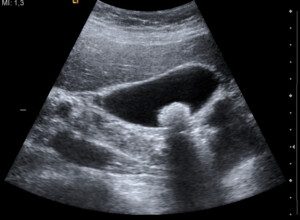
There’ve been a number of studies about the effectiveness of ultrasound for detecting gallstones, says Akram Alashari, MD, a trauma surgeon at Geisinger Medical Center in PA.
Dr. Alashari says that it’s key to recognize that “precise estimates of sensitivity and specificity are difficult to determine” because surgical confirmation of a negative sonogram is unlikely.
He cites a systematic review that showed that the sensitivity was 84 percent and specificity was 99 percent.
Rarely, advanced scarring and contraction of the gallbladder around gallstones will lead to a non-visualization of the gallbladder lumen, says Dr. Alashari, which has a specificity of 96 percent.
But this should also raise the possibility of cancer of the gallbladder.
The accuracy of a transabdominal ultrasound in detecting gallbladder disease, and whether or not it’s “missed,” is dependent on the ultrasonographer.
However, an experienced operator doesn’t mean a slam-dunk reading, because even with an experienced technician, Dr. Alashari says it’s a challenge “to determine the number or size of stones in the gallbladder,” particularly for very small stones: one to two mm in diameter.

Ultrasound of a gallstone. © Nevit Dilmen, CC BY-SA 3.0/ creativecommons.org/licenses/by-sa/3.0/Wikimedia Commons
A bunch of these tiny stones together may appear as one large stone during an ultrasound.

Dr. Alashari was formerly with Grand Strand Regional Medical Center in SC as an abdominal and critical care surgeon. He is the author of “THE POWER OF PEAK STATE.”
 Lorra Garrick has been covering medical, fitness and cybersecurity topics for many years, having written thousands of articles for print magazines and websites, including as a ghostwriter. She’s also a former ACE-certified personal trainer.
Lorra Garrick has been covering medical, fitness and cybersecurity topics for many years, having written thousands of articles for print magazines and websites, including as a ghostwriter. She’s also a former ACE-certified personal trainer.
.











